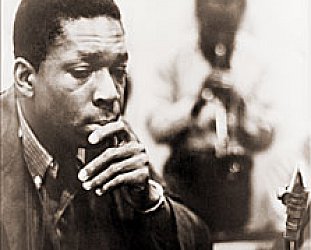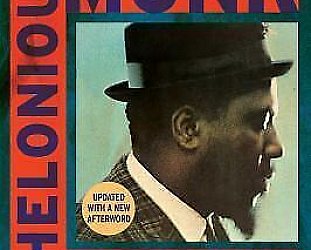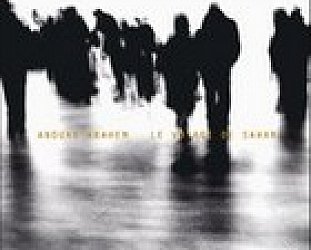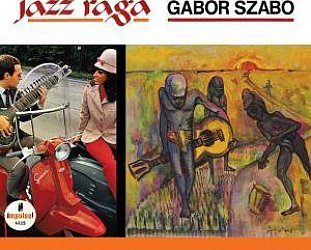Graham Reid | | 3 min read

Nobody talks about Rahsaan Roland Kirk much anymore. Maybe it’s because his recording career was too erratic, maybe because this sometimes fright-inducing multi-instrumentalist (literally, he could play three saxophones simultaneously) went kinda strange from time to time.
You know what some listeners are like – they are dullards who like things linear and consistent. Guys like Kirk don’t fit into that convenience shopping mentality.
Born in Ohio in ’36 and blind from shortly after birth, Kirk was one who never forgot the blues in his music, kept New Orleans close to his heart, Ellington’s legacy in mind, yet was most often associated with the avante-garde in jazz.
He was part of the great black tradition, yet on the liner notes to his Inflated Tear album in ’68 (an album which included the brilliantly entitled Lovellevelleliqui) he said that when he died he wanted to be cremated, “put in a bag of pot and beautiful people to smoke me.”
Ahh, hippie days...and there’s no evidence anyone took him up on this offer when he died after a stroke in late ’77.
In his short life he learned to play an astonishing 40 instruments (including bagpipes) and the idea of playing three instruments at once came to him in a dream when he was 16. Dreams were good to Kirk. The name Rahsaan came to him at night as well.
Yes mam, ol’ Roland was a wild’n’crazy genius alright. But that opinion widely held, also diminishes him. “Wild’n’crazy” is a kind of dumb-headed view. As with Albert Ayler – too few albums and floating face down in the Hudson in 1970 – it is too easy to be diverted by Kirk’s hyperventilating and not notice he was actually doing something with it.
In the early 90s when you thought the vaults had been thoroughly cleaned a new Kirk album, The Man Who Cried Fire, appeared. It was an interesting label, Night Records which specialised in live tapes, many from the private recordings of collectors – the Kirk, for example, mostly came from performances in the Keystone Korner Club in the mid-70s.
The Man Who Cried Fire was as much an oddity as a revelation.
Spoken snippets appear between the tracks: Kirk tells about meeting Miles Davis (then impersonating Davis’ barely audible croak and trumpet playing) and there is a spoken piece about how people think his accomplishments, like circular breathing (which allowed him to play notes and phrases continuously), or multi-instrumental workouts, are mere gimmickry.
Such “gimmickry” is easy to spot on the album.
On Multi-Horn Variation Kirk plays three instruments at once and on You Did it he spits and sings a bitter blues through a flute like Screamin’ Jay Hawins meets Jethro Tull. (In fact, Tull included a version of Kirk’s Song for a Cuckoo on their debut album back in ’68.)
Yep, The Man Who Cried Fire reinforces the notion that Roland was a sideshow in the freak circus of jazz.
Unfortunately for his critics there’s also the magic which gives the lie to the “wild’n’crazy” assessment.
After a spoken piece in which Kirk bemoans his status as a novelty item, producer Joel Dorn drops in the most sublime piece of Kirk playing with swinging Charlie Parker sweetness and following comments on the New Orleans tradition (Kirk’s wishes for his cremation included) there is a blast of searing Nawlins second-line party music followed by Kirk’s own stately, swinging funeral anthem The Black and Crazy Blues.
The Man Who Cried Fire was an apt title and described Kirk himself: black, from the tradition to free jazz with pit stops in r’n’b along the way. And crazy as all hell because he knew you were here just the once.
The Man Who Cried Fire isn’t the best Kirk you can buy (get the double live set Bright Moments for that particular trip) but there was humour and diversity aplenty on it.
Think of it as a sampler or, better a series of snapshots from a different place.
In that regard the packaging was helpful. There are ample cover notes with quotes from Kirk on Coltrane, his blindness (“I’m a man first, so-called blindness is secondary”) and New Orleans music.
There is also producer Dorn telling a fairly typical Kirk story. Kirk blindfolded him, then held a gun to his head when they were mixing some tapes. Kirk said he just wanted Dorn to know how he felt the whole time.
“He wasn’t out of control or angry or menacing or evil or anything,” says Dorn. “He was cool. He was just showing me something.”







mark robinson - Apr 6, 2010
>>the freak circus of jazz
Savemmmmmmmm.........?????
post a comment